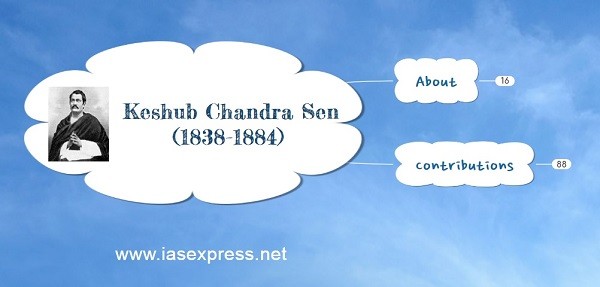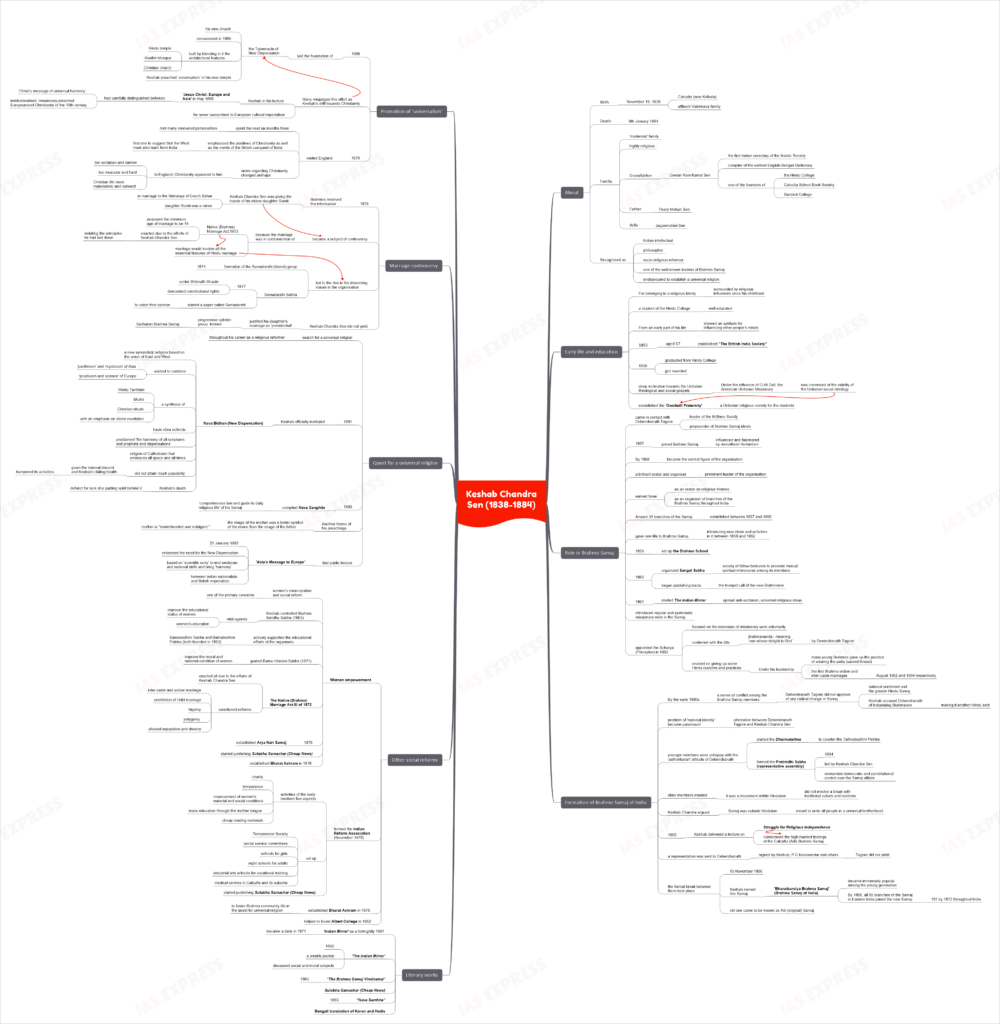Keshub Chandra Sen – Biography, Contributions, Literary Works

Keshab Chandra Sen (1838-1884) was an Indian intellectual, philosopher and socio-religious reformer. He was one of the well-known leaders of Brahmo Samaj. He endeavoured to establish a universal religion. His identity constantly kept changing from a scientist of faith to an exponent of Neo-Vaishnavism and Mother goddess, from revolutionary social reformer to restrained theoretician, from ardent constitutionalist to defender of authoritarianism, from an advocate of nationalism to a champion of ‘providential’ British rule.

This topic of “Keshub Chandra Sen – Biography, Contributions, Literary Works” is important from the perspective of the UPSC IAS Examination, which falls under General Studies Portion.
Early life and education
- Keshab Chandra Sen was born on November 19, 1838, into an affluent Vaishnava family in Calcutta (now Kolkata).
- He was the son of Peary Mohan Sen and the grandson of Dewan Ram Kamal Sen.
- His grandfather was the first Indian secretary of the Asiatic Society, the compiler of the earliest English-Bengali Dictionary (two volumes published in 1830 and 1834), and one of the founders of the Hindu College, Calcutta School-Book Society and Sanskrit College.
- Keshab Chandra’s family was a ‘modernist’ family while being highly religious at the same time. For belonging to a religious family, he was surrounded by religious influences since his childhood.
- Keshab Chandra was a student of the Hindu College and was well educated. From an early part of his life, he showed an aptitude for influencing other people’s minds.
- At the age of 17, in 1855 he established “The British India Society”.
- In 1856, he married Jagonmohini Sen and graduated from Hindu College, Calcutta.
- He had a deep inclination towards the Unitarian theological and social gospels propounded in the writings of Theodore Parker, FW Newman, RW Emerson, Miss Francis Cobbe and others.
- Under the influence of CHA Dall, the American Unitarian Missionary, he was convinced of the validity of the Unitarian social ideology and established the ‘Goodwill Fraternity’, a Unitarian religious society for the students, where he was the main speaker.
Role in Brahmo Samaj
- Soon he came in contact with Debendranath Tagore, the leader of the Brāhmo Samāj and propounder of Brahmo Samaj ideals.
- In 1857, he joined Brahmo Samaj, influenced and fascinated by monotheist Vedantism.
- By 1858, he became the central figure of the organisation. He was a brilliant orator and organiser and was a prominent leader of the organisation.
- He earned fame as an orator on religious themes and as an organizer of branches of the Brahmo Samaj throughout India. Around 31 branches of the Samaj were established between 1857 and 1866.
- Keshab gave new life to Brahmo Samaj introducing new ideas and activities in it between 1858 and 1862.
- In 1859, he set up the Brahmo School where weekly lectures were delivered and were greatly popular with the rising generation.
- In 1860, he organized Sangat Sabha, a society of fellow believers to promote mutual spiritual intercourse among its members. In the same year, he began publishing tracts which was the trumpet call of the new Brahmoism and the first chapter was called, “Young Bengal, this is for you”.
- In 1861, he started The Indian Mirror, an organ of the Brahma Samaj through which he spread anti-sectarian, universal religious ideas.
- He introduced regular and systematic missionary work in the Samaj. After being appointed the Acharya (Preceptor) in 1862, he focused on the extension of missionary work voluntarily. He was also conferred with the title of Brahmananda – meaning ‘one whose delight is God’ by Devendranath Tagore.
- As the Acharya of the Samaj, Keshab insisted on giving up some Hindu customs and practices such as the caste system, untouchability, child marriage, and polygamy and became the champion of widow and inter-caste marriages.
- Under his leadership, many young Brahmos gave up the practice of wearing the paita (sacred thread). It was during his leadership that the first Brahma widow and inter-caste marriages took place in August 1862 and 1864 respectively.
Formation of Brahmo Samaj of India
- By the early 1860s, there arose a sense of conflict among the Brahmo Samaj members. Debendranath Tagore did not approve of any radical change in Samaj keeping in view the national sentiment and the greater Hindu Samaj.
- Keshab accused Debendranath of Indianising Brahmaism, making it another Hindu sect. The problem of ‘national identity’ became paramount in the altercation between Debendranath Tagore and Keshab Chandra Sen.
- The younger members were unhappy with the ‘authoritarian’ attitude of Debendranath. To counter the Tattwabodhini Patrika, the young started the Dharmatattwa.
- To challenge Debendranath’s authority, the young members formed the Pratinidhi Sabha (representative assembly) in 1864 led by Keshab Chandra Sen. The group struggling for religious independence and progress in the Brahma Samaj, demanded democratic and constitutional control over the Samaj affairs.
- The older members insisted that it was a movement within Hinduism and did not involve a break with traditional values and customs while Keshab Chandra argued that the Samaj was outside Hinduism and was meant to unite all people in a universal brotherhood.
- In 1865, Keshub delivered a lecture on the Struggle for Religious Independence where he condemned the high-handed feelings of the Calcutta (Adi) Brahmo Samaj and a representation was sent to Debendranath signed by Keshub, P C Mozoomdar and others.
- Tagore did not yield and the formal break between them took place on 15 November 1866. Keshab named this Samaj- ‘Bharatbarsiya Brahma Samaj’ (Brahma Samaj of India) while the old one came to be known as Adi (original) Samaj.
- After the breakup, the Adi Brahmo Samaj quietly retreated to its position of Hindu monotheism – and Debendranath remained silent and never replied to any of the accusations.
- The tenets of the newly-formed body were as follows:
- The wide universe is the temple of God.
- Wisdom is the pure land of pilgrimage.
- Truth is the everlasting scripture.
- Faith is the root of all religions.
- Love is the true spiritual culture.
- The destruction of selfishness is true asceticism.
- Keshab’s Samaj became immensely popular among the young generation. By 1868, all 65 branches of the Samaj in Eastern India joined the new Samaj and the number rose to 101 by 1872 throughout India.
Promotion of ‘universalism’
- In 1868, Keshab Chandra laid the foundation of the Tabernacle of New Dispensation, his new church, which was consecrated in 1869.
- It was built by blending in it the architectural features of a Hindu temple, a Muslim Mosque and a Christian church. Keshab preached ‘universalism’ in his new temple.
- Many misjudged this effort as Keshab’s drift towards Christianity. However, Keshab in his lecture on ‘Jesus Christ: Europe and Asia’ in May 1866 had carefully distinguished between ‘Christ’s message of universal harmony’ and the institutionalised, missionary-preached Europeanised Christianity of the 19th century.
- He never succumbed to European cultural imperialism.
- In 1870, he visited England and spent the next six months there. He met many renowned personalities such as John Stuart Mill, William Gladstone and Queen Victoria.
- He emphasized the positives of Christianity as well as the merits of the British conquest of India. At the same time, he was the first one to suggest that the West must also learn from India.
- However, his views regarding Christianity changed perhaps. In England, Christianity appeared to him too sectarian and narrow, too muscular and hard, and Christian life in England was more materialistic and outward than spiritual and inward.
Marriage controversy
- In 1878, Brahmos received the information that Keshab Chandra Sen was giving the hands of his eldest daughter Suniti, who was a minor, in marriage to the Maharaja of Cooch Behar.
- This issue became a subject of controversy because the marriage was in contravention of the Native (Brahma) Marriage Act,1872. The Act proposed the minimum age of marriage to be 14 and Suniti was yet a minor. Moreover, the Native (Brahma) Marriage Act, 1872 was introduced and enacted due to the efforts of Keshab Chandra Sen. It was seen as Keshab Chandra violating the principles he had laid down.
- It was also observed that the marriage would involve all the essential features of Hindu marriage which were in sharp contrast to the Native (Brahma) Marriage Act, 1872.
- This led to the rise in the dissenting voices in the organisation resulting in the formation of the Samadarshi (liberal) group in 1874 and Samadarshi Sabha in 1877 under Shibnath Shastri which demanded constitutional rights. The dissenting group started a paper called Samadarshi to voice their opinion.
- However, Keshab Chandra Sen did not yield and justified his daughter’s marriage as ‘providential’. This led to the progressive splinter group forming the Sadharan Brahma Samaj on 15 May 1875 on a constitutional basis.
Quest for a universal religion
- The search for a universal religion was a matter of quest for Keshab Chandra Sen throughout his career as a religious reformer.
- In 1881, Keshab officially instituted Nava Bidhan (New Dispensation), a new syncretistic religion based on the union of East and West. In this new religion, he wished to combine the ‘pantheism’ and ‘mysticism’ of Asia with the ‘positivism and science’ of Europe.
- It was a synthesis of Hindu Tantrism, bhakti, and Christian rituals, with an emphasis on divine revelation.
- The basic idea of Nava Bidhan was eclectic. It proclaimed ‘the harmony of all scriptures and prophets and dispensations’. According to Keshab, it was a religion of Catholicism that embraces all space and all times.
- In 1883, Keshab compiled Nava Sanghita as a ‘comprehensive law and guide to daily religious life’ of his Samaj.
- Another theme of his preachings during this period was that the image of the mother was a better symbol of the divine than the image of the father since a mother is “tenderhearted and indulgent.”
- The central idea behind all these experiments was the quest for a universal religion.
- In his last public lecture, ‘Asia’s Message to Europe’, on 20 January 1883, he reiterated the need for the New Dispensation based on ‘scientific unity’ to end sectarian and national strife and bring ‘harmony’ between Indian nationalists and British imperialists.
- However, the New Dispensation did not attain much popularity given the internal discord and Keshab’s failing health, which hampered its activities. After Keshab’s death, it became defunct for lack of a guiding spirit behind it.
Other social reforms
- Women empowerment
- The issue of women’s emancipation and social reform for their betterment was one of the primary concerns of Keshab Chandra Sen.
- To improve the educational status of women, women’s education became a vital agenda of Keshab-controlled Brahma Bandhu Sabha (1863).
- He also actively supported the educational efforts of the organisers of the Bamabodhini Sabha and Bamabodhini Patrika (both founded in 1863) and guided Bama Hitaisini Sabha (1871) to improve the moral and material condition of women.
- The Native (Brahma) Marriage Act III of 1872 was enacted all due to the efforts of Keshab Chandra Sen. The progressive Act sanctioned reforms such as inter-caste and widow marriage, prohibition of child marriage, bigamy, and polygamy and allowed separation and divorce.
- In 1879, he established Arya Nari Samaj.
Death
- In 1883, Keshab Chandra’s health began failing, and he breathed his last on 8th January 1884.
Literary works
- ‘Indian Mirror’ as a fortnightly in 1861, became a daily in 1871.
- ‘The Indian Mirror’, 1862, a weekly journal, discussed social and moral subjects.
- “The Brahma Samaj Vindicated”, 1863.
- Sulabha Samachar (Cheap News).
- “Nava Samhita”, 1883.
- Bengali translation of Koran and Hadis.

